Inside The New York Botanical Garden
Sonia Uyterhoeven
Posted in Gardens and Collections on January 15 2009, by Sonia Uyterhoeven
 |
The Botanical Garden’s living collections is among the greatest in the world and contains more than 1 million plants. Jon Peter, Plant Records Manager, periodically shines the spotlight on a particular species that can be found within our 250 acres.
|

Botanical Name: Ilex verticillata
Common Name(s): Winterberry
Family Name: Aquifoliaceae (Holly family)
Native Range: USA—Maine to Florida, west to Minnesota and Texas
Canada—Newfoundland to Ontario
USDA Hardiness Zones: 3 through 9
Location(s) within NYBG: Native Plant Garden, Everett Children’s Adventure Garden, Home Gardening Center
Site Requirements: Sun to partial shade; well-drained, moist, organic soil; can tolerate extended periods of flooding
Interesting Note: This native species is one of a small number of hollies that are deciduous, losing their leaves in the autumn to reveal the orange to red berries that persist into winter. The berries become an important food source for birds when other sources diminish. Like all hollies, this species is dioecious, meaning it has separate male and female plants and both need to be present for pollination of flowers and subsequent production of fruit.
In a previous video entry, The Garden’s own Sonia Uyterhoeven talked about winterberry and other types of plants that provide beauty and food for wildlife.
Editor’s note: Though winter is not even a month old, birds have already eaten all the fruit from the Garden’s winterberry shrubs.
Posted in Gardening Tips on January 12 2009, by Sonia Uyterhoeven
Winter Wonderland
 Sonia Uyterhoeven is Gardener for Public Education at The New York Botanical Garden.
Sonia Uyterhoeven is Gardener for Public Education at The New York Botanical Garden.
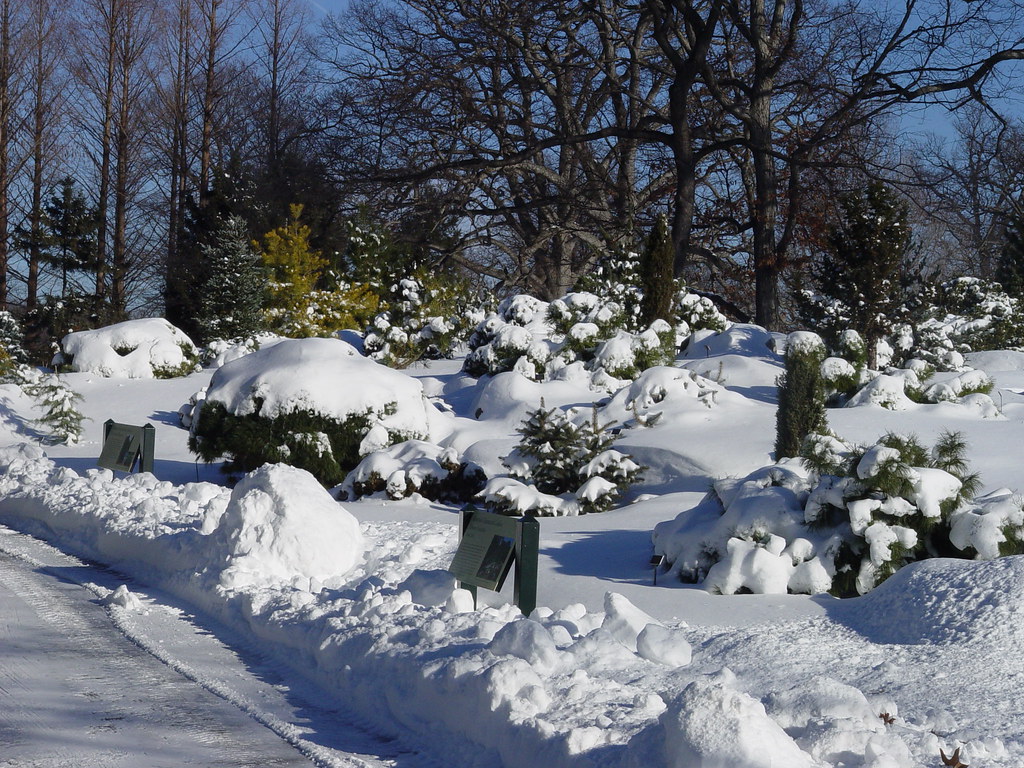 The Garden looks like a winter wonderland when it snows. The quiet and calm of the white landscape is deceptive. The aftermath of a storm causes us to scurry around shaking the snow off hedges and prized evergreen shrubs as well as clearing paths and benches.
The Garden looks like a winter wonderland when it snows. The quiet and calm of the white landscape is deceptive. The aftermath of a storm causes us to scurry around shaking the snow off hedges and prized evergreen shrubs as well as clearing paths and benches.
The yew hedge that delineates the perennial garden struggles under the weight of wet snow. Brooms and rakes (not shovels) are used to gently remove the snow. The snow blowers are instructed to point their machines away from the hedge to minimize unnecessary damage. When removing snow in your own home gardens, push upward with the broom rather than downward to minimize pressure. Remember not to use hedges and foundation borders as dump sites for excess snow.
Snow acts as an excellent insulator during the cold winter months. Small plants can remain covered, but larger or more fragile plants need to be shaken off to ensure that their branches are not disfigured or broken by the weight of the snow.
If you have a narrow, upright conifer (such as an arborvitae) that you are worried will lose its shape, tie susceptible branches with nylon tree ties or arbor ties that you can purchase at a garden center. If you are curious to see how this is done, come and inspect the small arborvitae located at the Fountain of Life in front of the library building. We carefully tie these trees in November. An alternative solution is to place a stake at the back of the tree and loosely wrap garden twine around the tree and stake starting at the bottom and moving upward. This can also be done without a stake by simply attaching the twine to the trunk of the tree and winding the twine around the branches.
These simple yet important steps are taken to ensure that the landscape of the Garden is not only beautiful but also well maintained throughout the winter and into the spring. They are easy for you to do in your own home gardens.
Posted in Gardening Tips on January 5 2009, by Sonia Uyterhoeven
Fragrant Wintersweet (Chimonanthus praecox)
 Sonia Uyterhoeven is Gardener for Public Education at The New York Botanical Garden.
Sonia Uyterhoeven is Gardener for Public Education at The New York Botanical Garden.
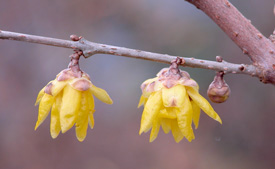 They say that nature is about observation, but sometimes it is about just following your nose. Chimonanthus praecox is one such example. It is an underused winter flowering shrub that is often eclipsed by the more popular Hamamelis (witch hazel).
They say that nature is about observation, but sometimes it is about just following your nose. Chimonanthus praecox is one such example. It is an underused winter flowering shrub that is often eclipsed by the more popular Hamamelis (witch hazel).
Fragrant wintersweet is a deciduous shrub that is hardy to zone 6b. It tends to be a multi-stemmed, loose-stemmed specimen with a fountain or vase-like shape. It does not have the structural composure that witch hazel possesses. It can get a little gangly with age. Happily, this 10- to 15-foot shrub can be severely cut back after flowering.
The main feature of this shrub is its fragrant winter bloom. It just started flowering in the Home Gardening Center (it’s planted behind the Sensory Garden) in mid-December and should remain in flower through the cold winter months.
It has small half-inch to 1-inch long flowers that look like shredded little cups. The inflorescence (floral structure) is broken down into layers. The outer layer has flat strap-like, waxy, yellowish-white, translucent tepals. The smaller tepals on the inner layer are burgundy. They are also translucent and remind me of what a first coat of burgundy nail polish looks like on your nails. What’s a tepal? It is the botanist’s name for when the flower part (sepals and petals) all look undifferentiated.
Never mind the anatomy, how about the fragrance? It has a pungent smell that is spicy and exotic. It reminds me of ylang ylang, the type of fragrance that gets trapped inside your nostrils.
With its pungent perfume and its poetic little flowers, can we then speculate on how Chimonanthus is pollinated? The general rule of thumb is that trees and shrubs with small, inconspicuous flowers are most likely wind pollinated. They don’t need to put on a show to attract a pollinator; they simply need to extend their branches so their pollen can get caught in a passing gust of wind.
Woody specimens with large, showy flowers and enticing perfumes tend to be insect pollinated. They lure their potential pollinators with sweet smells and sugary nectars. But who in their right mind would be flying about in the middle of winter?
When we look to other winter-flowering shrubs for clues, we are given none. Members of the Hamamelidaceae family such as witch hazel produce fragrant flowers during the winter. These woody plants are wind pollinated, although, curiously enough, fossil evidence indicates the possibility they were once insect pollinated.
Chimonanthus praecox is in the Calycanthaceae family. Members of this family are generally either fly or beetle pollinated. Small, open flowers tend to be fly pollinated while larger, intricate flowers are designed to trap beetles.
Is this exotically fragrant shrub then fly pollinated? The burgundy markings on the inner tepals and its graceful open whorl-like floral structure would suit that pollinator. But in the middle of winter?
Maybe in its native China there are small hovering flies or beetles buzzing around when the shrub is in flower. Here in New York, however, we have decided that Chimonanthus praecox is “nose-pollinated.” That is, it’s fragrance is so enticing that once you dip your nose in for a small whiff you will be back for more.
Posted in Gardening Tips on December 29 2008, by Sonia Uyterhoeven
Looking Back at the Year
 Sonia Uyterhoeven is Gardener for Public Education at The New York Botanical Garden.
Sonia Uyterhoeven is Gardener for Public Education at The New York Botanical Garden.
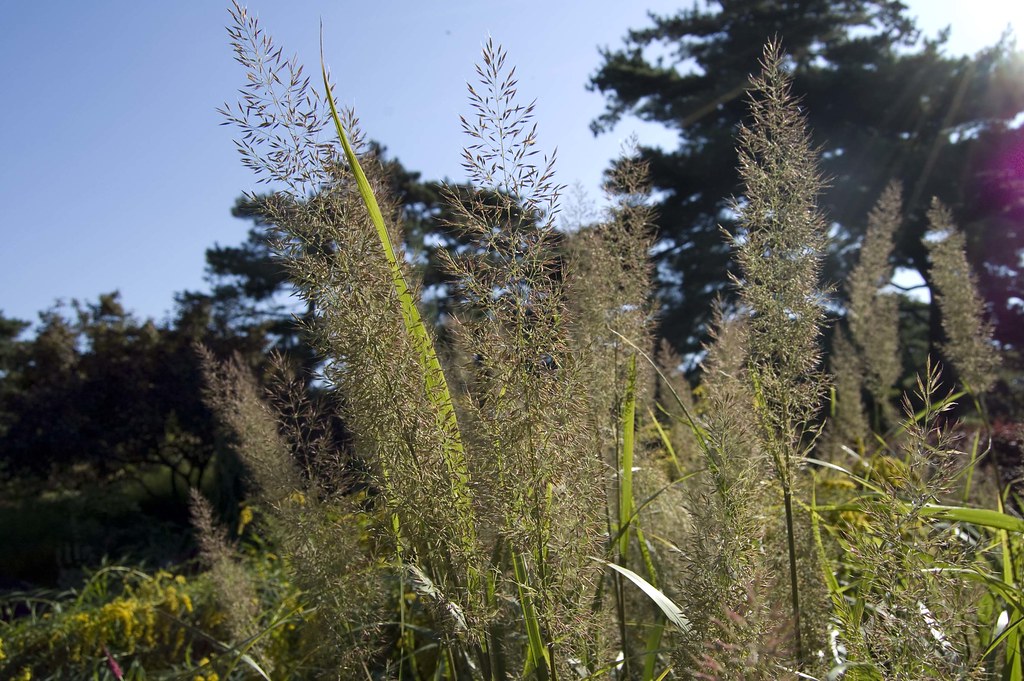 I was fortunate enough to spend two weeks in the Southeast of England this past July. As I toured around a handful of gardens, one thing that made a lasting impression was the size of the plants. With their cool summers and ample rainfall, perennials that grow three feet tall in the New York area were happily stretching up to four or five feet.
I was fortunate enough to spend two weeks in the Southeast of England this past July. As I toured around a handful of gardens, one thing that made a lasting impression was the size of the plants. With their cool summers and ample rainfall, perennials that grow three feet tall in the New York area were happily stretching up to four or five feet.
On this side of the pond the past year felt distinctly British. Spring lasted for more than a quick two-week spell with the cool weather and rain that extended well into May. July certainly had periods that were hot and the rains came infrequently in heavy downpours; the tropical plants in the Garden took notice and jumped into their full glory. August surprised me. Instead of the stifling heat and insufferable humidity that I have grown accustomed to, it was pleasant. The intense heat never came.
These are the moments that I wish I had a crystal ball. Had I known this ahead of time, I would have filled my perennial borders with lupines, penstemons, and delphiniums. I would have also cut back some of my larger, floppier customers such as the Montauk daisy (Nipponantheum) even harder than I normally do.
The ornamental grasses grew taller than I was accustomed to and needed more staking than in previous years. Many plants doubled in size and spread happily through the garden. My catmint (Nepeta) lost its sense of time and did not know when to stop flowering. Along with the lavender, it sent up sporadic blooms through the summer and well into fall. My Virginia sweetspire (Itea) decided that fall had come early and started to show its fiery reds as early as mid-August.
Observation is one of the finest tools that gardeners can posses. Gardeners not only work with plants, they work with nature. Observing nature and watching how changes in the environment directs and affects the growth and the cycles in the garden is one of the greatest gifts. It teaches gardeners more about plants than any textbook ever could.
Posted in Gardening Tips on December 22 2008, by Sonia Uyterhoeven
Lessons in Biodiversity and Sense of Place
 Sonia Uyterhoeven is Gardener for Public Education at The New York Botanical Garden.
Sonia Uyterhoeven is Gardener for Public Education at The New York Botanical Garden.
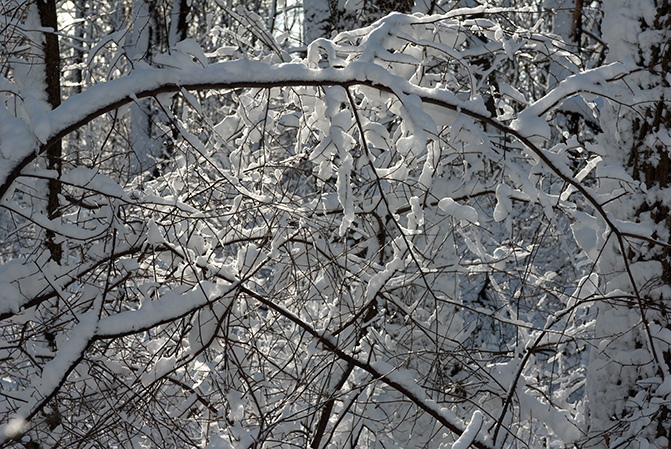 I recently attended a lecture on the art of ecological garden design and found a great deal of inspiration from the speaker’s ideology. I was reminded of the importance of a “sense of place.”
I recently attended a lecture on the art of ecological garden design and found a great deal of inspiration from the speaker’s ideology. I was reminded of the importance of a “sense of place.”
This is a design concept that has been around for years, but it was forcefully driven home with the reminder that a generic landscape—let’s say for the sake of simplicity a home surrounded by a green lawn—gives the viewer no sense of locality. You could be in Arizona, Alaska, Alabama, or anywhere in between.
With it comes the poignant reminder that we “no longer know where we are” and lose a sense of “who we are.” There is a loss of culture and tradition that disappears with the absence of locality.
Every part of the country has its own particular flavor.
If you are looking out your window and you see the knobby trunk of a pitch pine (Pinus rigidia), a beach plum (Prunus maritima), and expansive carpets of bearberry (Arctostaphylos uva-ursi) and broom crowberry (Corema conradii) covering sandy soil, then you are probably on Cape Cod. This is an image that is laden for many with certain associations, smells, and memories—generally good ones.
It is a memory of a diverse environment. This guru on ecological garden design reminded me that the experientially rich environment is full of textures, colors, movement, and sounds. With diverse plant palates comes the concomitant diversity in wildlife—the welcome as well as the unwelcome kind.
Monocultures often appear to be static and sterile, while one of the greatest joys of a natural environment is its dynamic system that celebrates seasonality. If beauty and abundance is not enough to convince the reader of the importance of diversity, then know that an ecological garden works with its surrounding rather than against it so is much less of a maintenance challenge. It certainly doesn’t require the quantity of chemicals that we have to dump into our lawns to keep them green.
Does this mean we should do away with the generic lawn? Certainly not! I would hate to lose the spot for the lawn chair, the badminton game, or the barbeque. With a little planning we can have the best of both worlds—patches of organically maintained lawn woven into a diverse and ecologically sound garden. This is how we can flourish and grow into the future.
Posted in Gardening Tips on December 15 2008, by Sonia Uyterhoeven
Growing Herbs Indoors
 Sonia Uyterhoeven is Gardener for Public Education at The New York Botanical Garden.
Sonia Uyterhoeven is Gardener for Public Education at The New York Botanical Garden.
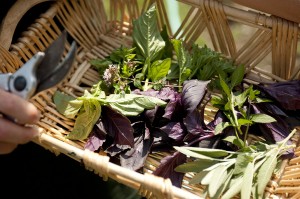 As winter winds chill your bones, some of your summer pastimes can be successfully re-created in the home. One of my favorites is growing herbs on a windowsill. My biggest challenge is overuse. Healthy plants get nightly haircuts until they dwindle into a small patch of nothingness.
As winter winds chill your bones, some of your summer pastimes can be successfully re-created in the home. One of my favorites is growing herbs on a windowsill. My biggest challenge is overuse. Healthy plants get nightly haircuts until they dwindle into a small patch of nothingness.
For those of you who are able to exercise better restraint, many herbs can be grown indoors and will happily survive on a sunny windowsill. Basil, chives, parsley, thyme, and oregano are easy to grow. Rosemary is trickier to grow as it needs a cool room (around 60°F) and high humidity. Most herbs require six hours of sunlight to thrive. Bright southern or western exposure is best. Parsley, rosemary, and mint can take less light.
All herbs are unhappy with the dry, stagnant air common in homes during the winter months. Some antidotes: occasionally crack open a window or periodically run a small oscillating fan; keep household temperatures in the 70s; mist plants daily, place them on top of a pebble tray, or invest in a humidifier that will benefit both you and your green guests.
Use water at room temperature for herbs. Some such as marjoram, oregano, sage, and thyme need to dry out between watering—meaning when the soil surface is dry. Rosemary and mint will resent dry periods and shouldn’t be allowed to completely dry out. Make sure that water doesn’t collect or sit on the leaves of your herbs, otherwise they will rot. Basil is particularly susceptible.
Indoor herbs, like all of your houseplants, will gather dust and will require an occasional bath. Take a soft sponge or paper towel and clean the leaves. Alternatively, gently run it under the shower or the tap. While herbs don’t need fertilizing when they are growing outdoors, a monthly boost of half-strength fish emulsion will help keep your winter windowsill herbs thriving.
If the herbs are moving from outdoors to indoors they should be potted up before the first frost. If they undergo a reverse hardening off procedure they will have a better chance of adjusting to your home environment. Place the containers in a slightly shady area for a week to prepare them to the lower light levels of the home. Gradually bring them in for a few hours every day until you are ready to provide them with a new home.
When bringing your herbs indoors from the garden, many will benefit from being cut back by half. Some examples are rosemary, mint, sage, thyme and oregano. Remember that herbs love haircuts—it keeps the growth nice and tender and tasty. Growing herbs in your home is fairly easy; the hardest choices you will face is whether you should put them in your salad or on the roasted chicken.
Posted in Gardening Tips on December 8 2008, by Sonia Uyterhoeven
Snow in the Garden
 Sonia Uyterhoeven is Gardener for Public Education at The New York Botanical Garden.
Sonia Uyterhoeven is Gardener for Public Education at The New York Botanical Garden.
 Snow is one of nature’s greatest insulators. As long as it is not crushing a plant or placing too much weight on vulnerable branches, why not let it naturally pile up. It shouldn’t be a problem; in fact, it may actually help the plant weather the season.
Snow is one of nature’s greatest insulators. As long as it is not crushing a plant or placing too much weight on vulnerable branches, why not let it naturally pile up. It shouldn’t be a problem; in fact, it may actually help the plant weather the season.
In the Garden, we do have areas where we need to remove snow such as from our yew hedges, which could be damaged and disfigured by heavy snow. We gently remove heavy snow from hedges and specimen trees by using a broom or broom handle and slowly pushing upward. If the snow has iced over, we wait until the sun warms it up.
Do not try to break off ice crystals or be too hasty in your treatment. The trees and hedges are stressed enough in the winter months and patience is one of your greatest virtues. Avoid using a shovel; it tends to be too heavy, unwieldy, and sharp and will damage branches. If you are in a hurry or have a large area to cover, try a snow blower on low volume.
Mark your driveway with reflectors so that you delineate areas to be plowed before the snow piles up. Do not shovel or plow snow onto valuable trees and shrubs. While this sounds like common sense while sitting at your computer, this decision is not always straightforward when you are holding a shovel full of heavy snow. Not only will the force damage branches, but you will be piling up harmful salt residues.
Be careful of damaging plants with salt runoff from paths and sidewalks. Salt burns plants and kills root systems. Rather than using sodium chloride, try products that contain calcium chloride or magnesium and potassium chloride. Two products that do less damage to plants and that you can easily find at a hardware store or The Home Depot are Lescomelt2™ and Combotherm™.
If salt damage does occur, use gypsum (hydrated calcium sulfate) to counteract the salt at a ratio of 20 pounds per 100 square feet. As with any product, read the label and follow the directions for best results.
Posted in Gardening Tips on December 1 2008, by Sonia Uyterhoeven
Best Trees for the Holidays
 Sonia Uyterhoeven is Gardener for Public Education at The New York Botanical Garden.
Sonia Uyterhoeven is Gardener for Public Education at The New York Botanical Garden.
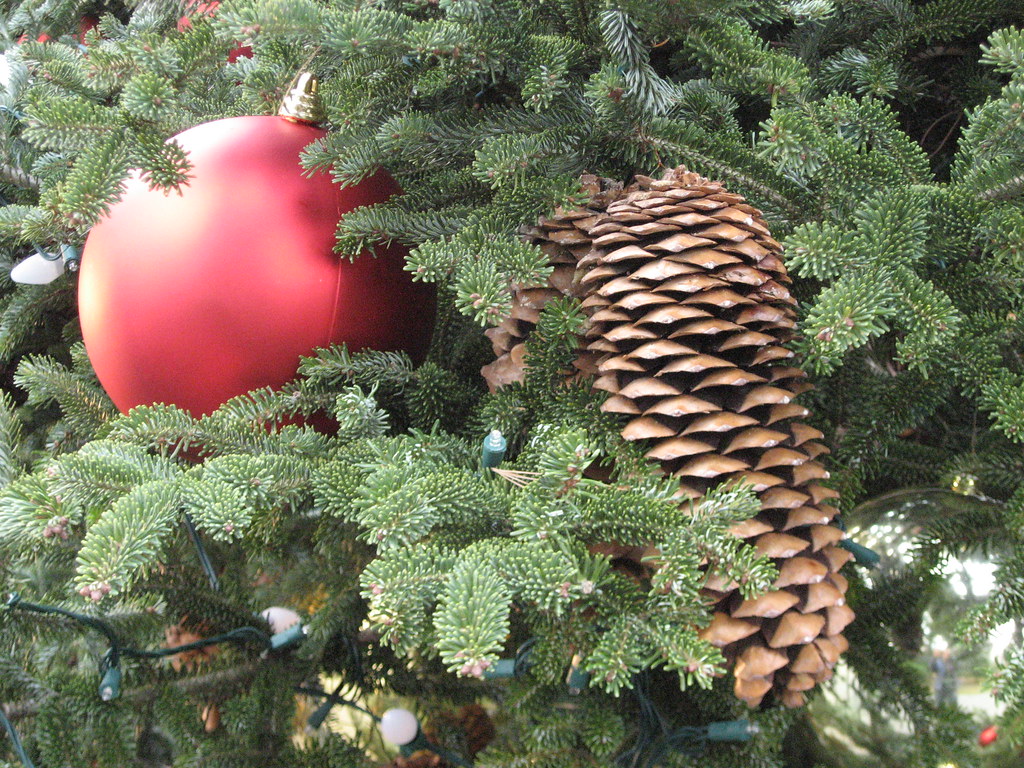 The most common Christmas tree you will find on the market is the Balsam fir (Abies balsamea). It makes a great cut tree that has a nice fragrance and possesses the all-important quality of good needle retention. It grows in cold climates—generally Canada and Maine—and is also one of the cheapest Christmas trees you will find.
The most common Christmas tree you will find on the market is the Balsam fir (Abies balsamea). It makes a great cut tree that has a nice fragrance and possesses the all-important quality of good needle retention. It grows in cold climates—generally Canada and Maine—and is also one of the cheapest Christmas trees you will find.
The Frasier fir (Abies fraseri) is another popular choice. It is slightly more expensive and has a nice blue-green cast to it. It heralds from more southern regions in the Alleghany mountain area. It also has good needle retention and makes an excellent cut tree.
On the West Coast, a traditional choice for Christmas trees is the Douglas fir (Pseudotsuga menziesii). Not a true fir, it is generally grown in Montana for the cut-tree trade and sold in the Pacific Northwest.
Firs tend to do well in the home, as do pines. The problem with pines is that they don’t possess the same strong branch structure that you will find in a fir. Spruces tend to loose there needles, although some people are adamant about buying a blue spruce (Picea pungens ‘Glauca’) as their Christmas tree, and it does create a lovely sight.
Measure the area where you will put your tree before you buy it and make sure it is one foot shorter than the ceiling height to compensate for the height of the tree stand. When purchasing a tree, make sure the needles are still supple; shake the tree gently—only a few needles should fall off. Store the tree in a cool garage if you are not yet ready to bring it into your home.
Cut a half-inch off the base of the tree and place it in water. Check the water daily; make sure there is always a good supply so that the tree doesn’t dry out. You will notice that the tree absorbs a great deal of water (up to a gallon) when it is freshly cut. Place the tree in a cool room, away from heat sources, and enjoy!
Posted in Gardening Tips on November 24 2008, by Sonia Uyterhoeven
Decorating the Home
 Sonia Uyterhoeven is Gardener for Public Education at The New York Botanical Garden.
Sonia Uyterhoeven is Gardener for Public Education at The New York Botanical Garden.
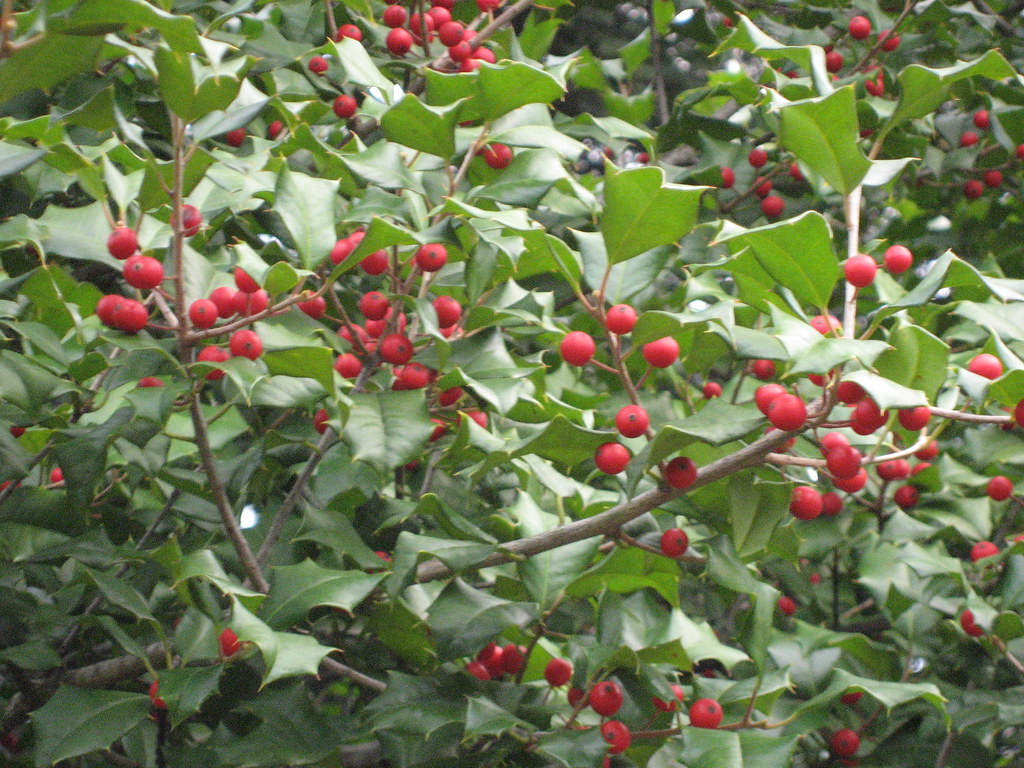 Around the holidays the home feels festive. Creating a holiday centerpiece is a fun way of adding some green into the scene and adorning your home. To start, place a saturated piece of florist foam in a bowl and begin to build your masterpiece.
Around the holidays the home feels festive. Creating a holiday centerpiece is a fun way of adding some green into the scene and adorning your home. To start, place a saturated piece of florist foam in a bowl and begin to build your masterpiece.
Suitable materials that you will find at this time of year are: colored dogwood stems, luxuriously shiny magnolia foliage, eucalyptus, holly covered with bright berries, berried juniper, incense cedar, Frazier fir, and white pine. Brighten them up by including roses, chrysanthemum, or South African proteas, and add a finishing touch with bows, pine cones, fruit, cinnamon sticks, or large nuts.
When making centerpieces with pine, remove the sticky sap from your hands and clothing with an oil-based lotion (for your hands) and either rubbing alcohol or witch-hazel for your hands or clothing. The easiest way to clean your tools is to spray them with WD-40.
If you prefer flowers in a vase, all of the materials above will work beautifully. If you are designing an arrangement in a large vase and are worried that the weight will shift to the sides rather than remain evenly spaced, reach in the drawer and pull out your cellophane tape. Create sections or divisions by stretching the tape over the mouth of the vase. This can be done from two sides to create a crisscross pattern.
Instead of filling the bottom of a clear vase with pebbles or marbles, try adding cranberries; the cranberries will last up to a week in water and will add a festive feel to the arrangement.
For another way to decorate your home with botanicals, see our blog post and instructional video with Madeline Yanni, Making a Botanical Wreath for Your Holiday Table.
Posted in Gardening Tips on November 17 2008, by Sonia Uyterhoeven
Protecting Plants
 Sonia Uyterhoeven is Gardener for Public Education at The New York Botanical Garden.
Sonia Uyterhoeven is Gardener for Public Education at The New York Botanical Garden.
 It is time to think about protecting your plants for the cold winter months. With roses, here we simply “hill them up” with 6-8 inches of mulch. After the temperature drops and the roses go dormant, usually in late November to early December, we pile a small mound of mulch around the base of the plant. This acts as a winter parka, protecting the base of the rose from freezing temperatures. Once the weather warms in March, we pull away the mulch and start preparing for spring.
It is time to think about protecting your plants for the cold winter months. With roses, here we simply “hill them up” with 6-8 inches of mulch. After the temperature drops and the roses go dormant, usually in late November to early December, we pile a small mound of mulch around the base of the plant. This acts as a winter parka, protecting the base of the rose from freezing temperatures. Once the weather warms in March, we pull away the mulch and start preparing for spring.
Some of your shrubs, such as the bigleaf hydrangeas (Hydrangea macrophylla)—mophead and lacecap types—flower on old wood. This means that the plant develops its flower buds on the previous year’s growth. Sometimes cold or variable winter weather (changing from warm to cold) can disrupt the flowering, killing off potential buds for the following season. One way to protect your hydrangeas that are situated in an exposed area and at the mercy of the elements is to provide a wind break. Place 5 or 6 stakes around the plant and wrap with burlap. The top can be kept open so that snow (nature’s greatest natural insulator) can fall in.
If it is containers that you are concerned about, the simplest answer is Bubble Wrap. Garden centers sometimes sell a horticultural version that has a silver foil lining with Bubble Wrap inside. Insulate hardy containers once they freeze; with half-hardy containers, insulate before they freeze. Wrap the container with Bubble Wrap and secure with garden twine. If possible, tie the Bubble Wrap over the top of the container, pulling it up around the base of the plants so that the soil in the container is covered. This will help protect it from the freezing and thawing cycle that usually happens in February. If your container is not hardy, place it in an unheated garage so that it can go dormant for the winter.







 I recently attended a lecture on the art of ecological garden design and found a great deal of inspiration from the speaker’s ideology. I was reminded of the importance of a “sense of place.”
I recently attended a lecture on the art of ecological garden design and found a great deal of inspiration from the speaker’s ideology. I was reminded of the importance of a “sense of place.”



